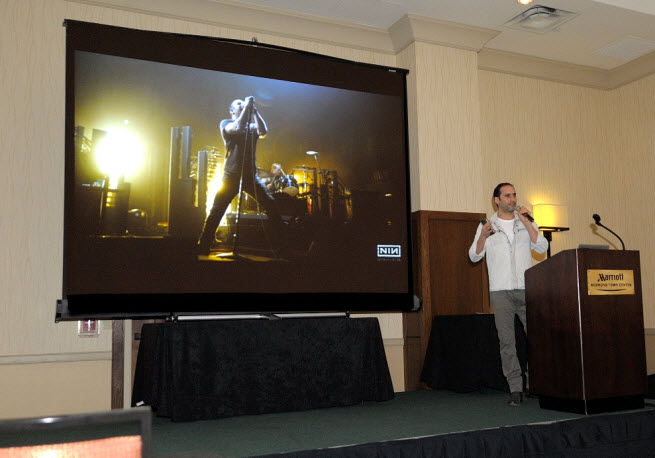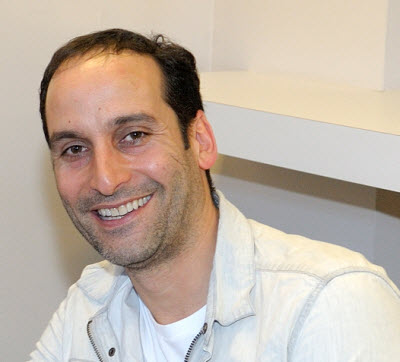GamesBeat: Given your past endeavors, like 42 Entertainment, what have you learned that you think is going to be something you’ll pull forward into this new way of doing TV?
Lee: A big thing I’ve learned is, figure out how to make your audience feel powerful because of the things they’re already good at. In this endeavor right now, that becomes very important.
Television is not broken right now. Television is better than it’s ever been. We have better stories. We’re figuring out delivery mechanisms. It’s amazing. So to come in and say, “Let’s fix television!” is a terrifying prospect. We don’t want to fix something that’s not broken.
So I’ve learned to respect the audience for what they’re already good at. They’re good at being passive. They’re good at experiencing TV shows that way. Let’s not fix that part. Instead, let’s learn from my knowledge of video games, my knowledge of viral marketing, my knowledge of building these compelling interactive narratives and deep immersion narratives, and say, “Listen. Audiences are going to sit back and watch a story. That’s awesome. If they choose, if they opt in to poke at the story and dig deeper, then let’s make a story that pokes back. If they want more narrative, let’s give them more, but if they don’t ever care to look, let’s not make them feel bad about that. Let’s make them feel amazing about that.” They get rewarded, through the narrative, for being exactly who they are and feeling like an extraordinary version of themselves, no matter what action they take.
Lee: Those experiments are amazing. I look at all of them, both the successes and the failures, because there’s so much to learn. If you imagine a spectrum, on the left is video games, and on the right is television. Left, completely active. Right, completely passive. What we’re experimenting with now is, we know there’s this craving for something in the middle.
We know we want our video games to be more like TV, because those narratives are so compelling. We know we want our TV to be more like video games, because we want to feel more empowered over the story. We want to be able to poke at it and get more out of it. But if you look at that spectrum, all of the different experiments you can place on that scale somewhere.
I believe the future is not in the middle. It’s much closer to the TV side. It’s not pegged out on the passive end, but it’s a few steps to the left of TV. It’s mostly passive, with a few interactive components that are a really easy ramp into the experience, a really low barrier to entry. Again, don’t break TV. Suggest enhancements that are optional if you want them.
GamesBeat: You have this platform with nearly 50 million Xbox Live members. What is it about the Xbox platform or the Xbox One in particular gives you the base that you need to work with?
Lee: The Xbox One is particular is so connected. It’s connected to your living room with gesture and voice recognition. Smartglass will connect to any smart device you throw at it. Suddenly you can start to play around with what it means to have an interactive story.
Let’s say you’re watching Game of Thrones and there’s an archer on the screen. He’s on top of a castle tower looking out across a valley and he sights the enemy coming across the field on horseback. He takes a bow and arrow and pulls back the arrow and lets fly. You see it fly across the TV screen, across the valley, across your living room, and on to your phone, where it lands with a thud as the thing shudders in your hand.
That’s a device. That’s an ecosystem of devices, aware of its environment and aware of how to use those systems to make storytelling more immersive. That’s an arrow that was just shot into your hand. How cool is that? How can we use elements like that for deeper and more engrossing storytelling? I’m not saying we’re going to do exactly that. But being aware of what these things are capable of makes for a whole new generation of stories that the Xbox can tell.
 GamesBeat: You’re doing this in Hollywood. How does that help you?
GamesBeat: You’re doing this in Hollywood. How does that help you?
Lee: It’s important that Microsoft decided to open the studio in Hollywood, instead of in Redmond. We have to be where the talent is. Microsoft needs to be able to partner up with the best storytellers in the world. All of this technology, all of this hardware, all of these networks, they completely fail if the story isn’t good. Story is absolutely the most important thing.
We have to live in the same town as those triple-A storytellers. We have to couple our technology prowess with their storytelling talents to create the future of living-room entertainment.
GamesBeat: What kind of interaction do you have across these different disciplines — the people in Redmond making games, the people in L.A. making film?
Lee: Microsoft has a number of studios spread out across the world. There’s obviously a huge technology base in Redmond. There’s the interactive sports team up in Vancouver. Additional device teams are all over the bay area. Then there’s us, the TV studio in L.A.
One of my big jobs, I’m on a plane every week at this point, traveling to these various studios to make sure we get the best of all those worlds. We’re all working together closely. Everyone’s aware of what everyone else is doing. We can use the power of Microsoft and this investment that we’ve already made to tell the best stories possible.
VentureBeat's mission is to be a digital town square for technical decision-makers to gain knowledge about transformative enterprise technology and transact. Learn More


